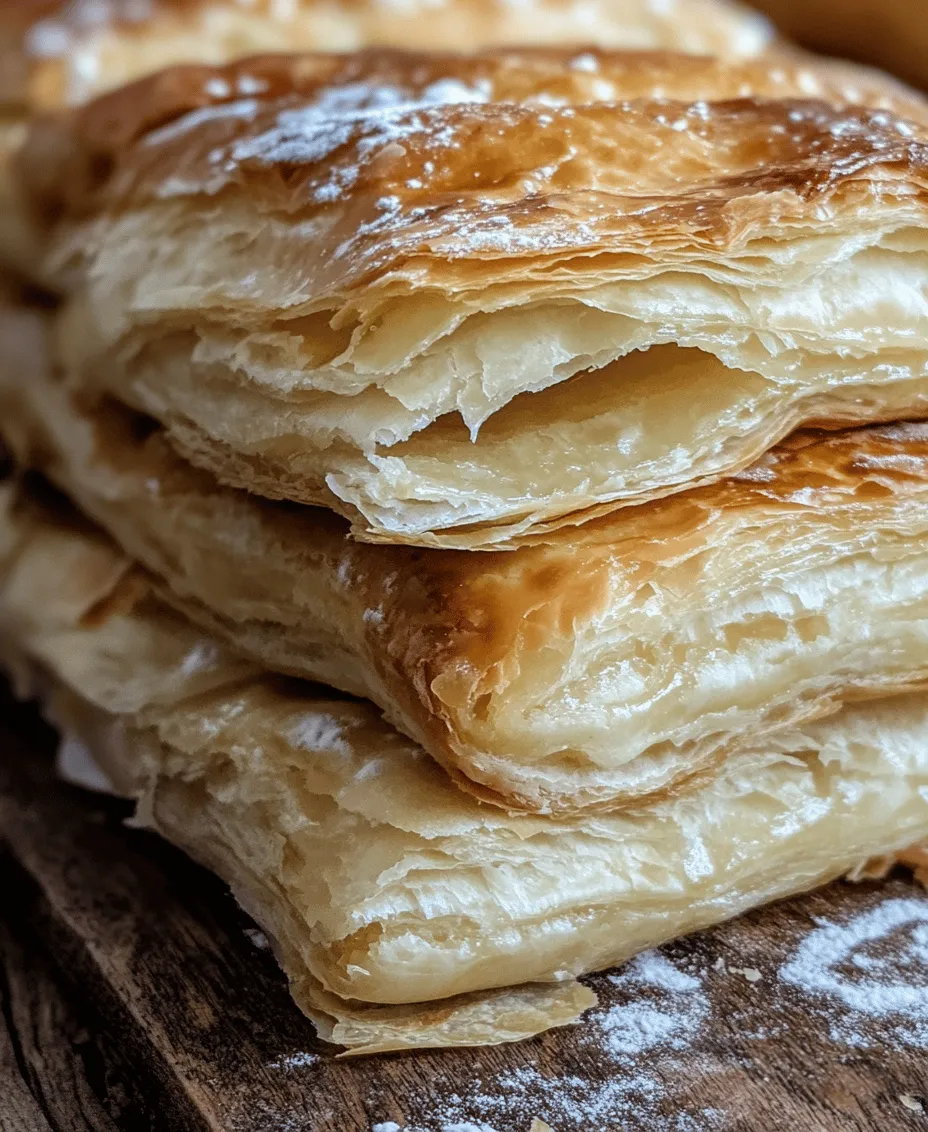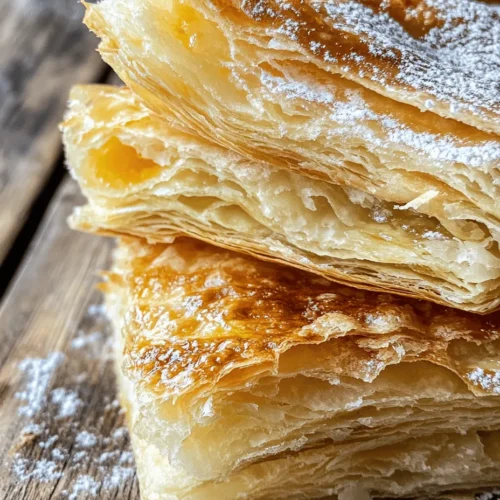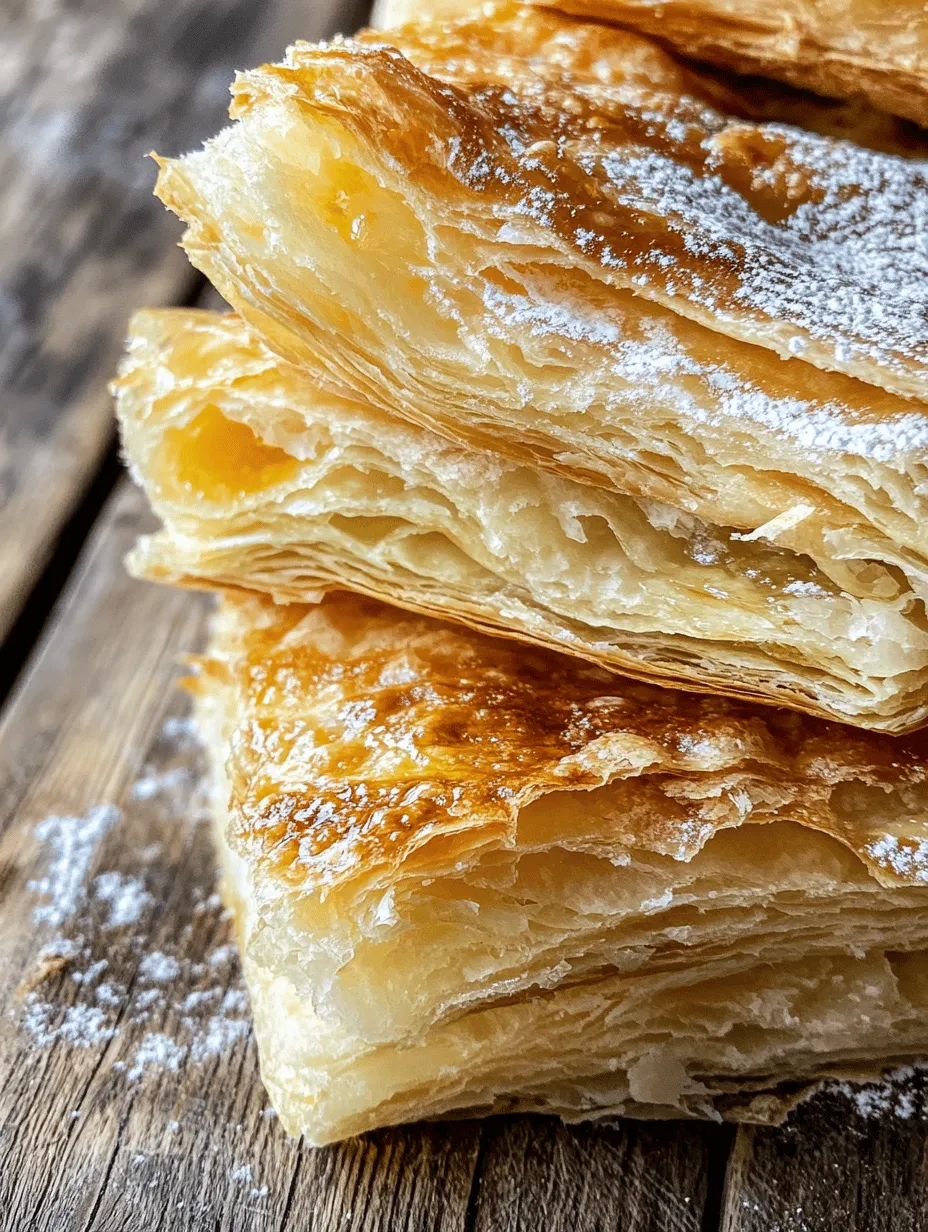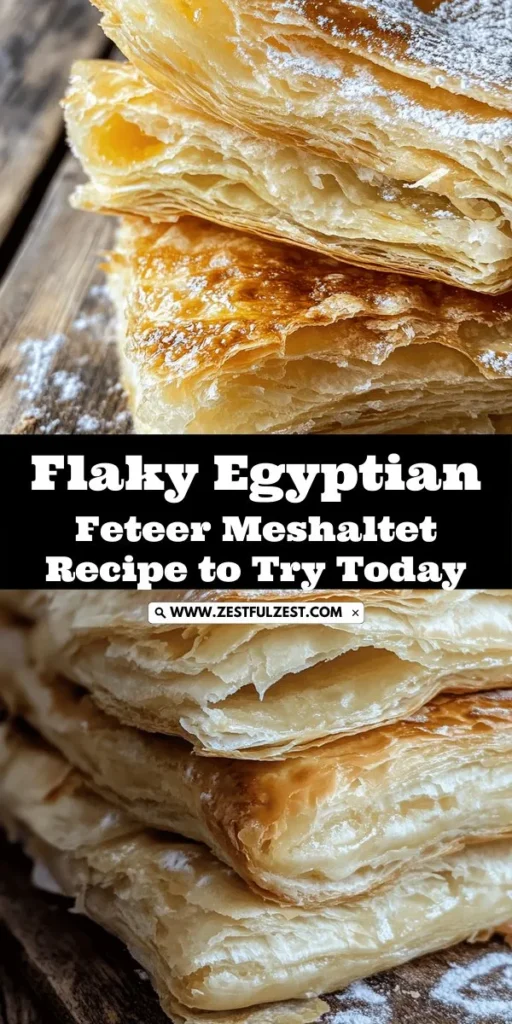Introduction
Feteer Meshaltet, often referred to simply as Feteer, is a traditional Egyptian pastry that has captured the hearts and palates of many both within Egypt and beyond. Known for its incredibly flaky layers and rich, buttery flavor, this pastry is a culinary delight that embodies the essence of Egyptian cuisine. Whether enjoyed as a breakfast treat, a savory snack, or a sweet dessert, Feteer Meshaltet has earned its place as a staple in Egyptian households, often served during special occasions and family gatherings.
The significance of Feteer in Egyptian culture extends beyond its delightful taste. It represents a tradition of hospitality and sharing, often made to celebrate important milestones, family gatherings, and festive occasions. As such, mastering the art of making Feteer Meshaltet is not just about creating a delicious pastry; it’s about embracing a culinary heritage that has been passed down through generations.
In this article, readers can expect to learn an authentic recipe for Feteer Meshaltet, along with detailed preparation techniques and serving suggestions that will allow you to recreate this beloved pastry in your own kitchen. From understanding the origins of this delicious treat to mastering the dough preparation, we will guide you through every step of the process.
Understanding Feteer Meshaltet
Origins and History of Feteer Meshaltet
Feteer Meshaltet has its roots deeply embedded in the rich culinary landscape of Egypt. This pastry dates back hundreds of years, with some historians tracing its origins to ancient Egypt, where it was made for the pharaohs. Over the centuries, Feteer has evolved, incorporating various ingredients and techniques that reflect the changing tastes and traditions of the Egyptian people.
Traditionally, Feteer was made by hand, with skilled bakers expertly stretching and folding the dough to create the signature flaky layers. This labor-intensive process was not only a testament to the baker’s skill but also a symbol of the communal spirit, as families would often gather to make Feteer together. Today, while modern techniques may simplify the process, the essence of Feteer remains the same – it is a labor of love that celebrates Egyptian heritage.
The Cultural Significance of Feteer
Feteer Meshaltet holds a special place in the hearts of Egyptians, often associated with celebrations and gatherings. It is commonly served during festive occasions such as Ramadan, weddings, and family reunions. Its versatility allows it to be prepared in various ways – whether filled with sweet fillings like honey, nuts, and cheese, or savory options like minced meat or vegetables. This adaptability makes Feteer a beloved dish that can be enjoyed by everyone, regardless of taste preference.
Moreover, Feteer is frequently enjoyed with a variety of accompaniments, such as honey, jam, or a sprinkle of powdered sugar, enhancing its flavor profile. The act of sharing Feteer among family and friends reinforces the bonds of community and togetherness, making it more than just a meal; it is a symbol of hospitality and warmth.
Variations of Feteer Throughout Egypt and the Middle East
While Feteer Meshaltet is most commonly associated with Egypt, this delightful pastry has inspired numerous variations throughout the Middle East. Each region has its unique take on Feteer, incorporating local ingredients and flavors. For instance, in some areas, it may be filled with rich cheeses, while in others, it may be served with a variety of dips.
In Egypt, you will find Feteer prepared in different styles, such as Feteer Asab, which is a thicker version of the pastry, often filled with more robust ingredients. Similarly, in neighboring countries, like Lebanon and Syria, variations of Feteer can be found, showcasing the culinary influences and shared heritage of the region.
Ingredients Breakdown
To create the perfect Flaky Egyptian Feteer Meshaltet, it is essential to use high-quality ingredients that contribute to its signature texture and flavor. Below is an overview of the key ingredients required for this recipe.
All-Purpose Flour
All-purpose flour is the backbone of Feteer Meshaltet, providing the necessary structure and texture for the dough. When choosing flour, it is important to select a high-quality brand that has a good protein content to ensure optimal gluten development. This gluten is what gives the pastry its distinctive flaky layers and chewy texture.
Salt and Sugar
Both salt and sugar play crucial roles in balancing the flavors of the pastry. Salt enhances the overall taste, while sugar adds a subtle sweetness that complements the buttery richness of Feteer. It is important to measure these ingredients accurately to achieve the perfect flavor balance.
Butter
Butter is the star ingredient in Feteer Meshaltet, responsible for creating its signature flaky layers. When layered into the dough, the butter melts during baking, creating steam that separates the layers and results in a light, airy pastry. For the best results, use unsalted butter, as this allows for better control over the saltiness of the final product.
Yeast
Yeast is essential for the rise and texture of the dough. It ferments, producing carbon dioxide gas, which helps the dough expand and become light and airy. Using fresh yeast is vital to ensure proper fermentation and a good rise, while also contributing to the overall flavor of the pastry.
Optional Ingredients
In addition to the main ingredients, some recipes may suggest the addition of milk powder. This ingredient can enhance the flavor and texture of the dough, resulting in an even richer pastry. However, it is not mandatory, and Feteer Meshaltet can be successfully made without it.
Sourcing Quality Ingredients
To achieve the best results, sourcing quality ingredients is of utmost importance. Look for fresh, high-quality flour, butter, and yeast from reputable suppliers. Local markets often carry fresh, artisanal products that can elevate your Feteer Meshaltet. Additionally, experimenting with different brands of flour and butter can lead to varied results, so feel free to explore until you find the combination that works best for you.
Step-by-Step Instructions
Now that we have discussed the essential ingredients for making Feteer Meshaltet, let’s delve into the step-by-step instructions for preparing the dough.
Preparing the Dough
Mixing the Ingredients
Begin by measuring out all your ingredients accurately. In a large mixing bowl, combine the all-purpose flour, salt, and sugar. Mix these dry ingredients thoroughly to ensure an even distribution of flavors. Next, create a well in the center of the flour mixture and add the yeast, followed by warm water. The water should be lukewarm, around 110°F (43°C), which is ideal for activating the yeast without killing it.
Gently mix the ingredients together until a rough dough begins to form. At this stage, you may find it easier to switch to using your hands. Incorporate all the flour from the sides of the bowl until the dough comes together.
Achieving the Right Dough Consistency
Once the dough has formed, it may appear slightly sticky. This is normal; however, you want to ensure it is not overly sticky. If the dough clings excessively to your hands, gradually incorporate more flour until you achieve a smooth, elastic consistency. Avoid adding too much flour, as this can lead to a dense pastry.
Kneading Techniques
Importance of Kneading for Gluten Development
Kneading is a critical step in dough preparation, as it develops the gluten strands that give Feteer its characteristic texture. Once you have achieved the right consistency, transfer the dough to a lightly floured surface. Using the heels of your hands, push the dough away from you, then fold it back over itself. Repeat this process for about 8-10 minutes, or until the dough becomes smooth and elastic.
You can tell that the dough is ready when it springs back to its original shape after being pressed. It should also feel soft and pliable to the touch.
Signs That the Dough is Ready for Rising
After kneading, shape the dough into a ball and place it in a lightly greased bowl, turning it to coat the surface with oil. Cover the bowl with a damp cloth or plastic wrap and let it rise in a warm, draft-free area for about 1 to 2 hours, or until it has doubled in size. The rising process is crucial, as it not only allows the dough to develop flavor but also contributes to the flakiness of the final pastry.
Letting the Dough Rise
Once the dough has doubled in size, it is ready for the next steps in the Feteer Meshaltet preparation process. Gently punch down the risen dough to release any trapped air bubbles, then turn it out onto a lightly floured surface. Now that you have a well-prepared dough, you are one step closer to creating the delicious, flaky layers that make Feteer Meshaltet a true delight.
Stay tuned for the next part of this article, where we will guide you through the rolling, layering, and baking processes that will transform your dough into the exquisite Feteer Meshaltet, perfect for sharing and enjoying with loved ones.

Ideal Conditions for Dough Rising
Achieving the perfect rise for your Feteer Meshaltet starts with understanding the ideal conditions for dough rising. Temperature and humidity play crucial roles in fermentation. The optimal temperature for rising dough is around 75°F to 80°F (24°C to 27°C). If your kitchen is cooler, consider placing the dough in a slightly warmed oven (turned off) or near a warm spot in your home.
Humidity is equally important. A drier environment can lead to tough dough, while excessive humidity can make it overly sticky. Aim for a balance; if your environment is too dry, you may need to cover the dough with a damp cloth or plastic wrap to retain moisture. Conversely, if it’s too humid, lightly dust your work surface with flour to prevent sticking while rolling out the dough.
Importance of Timing in Achieving the Perfect Rise
Timing is essential when it comes to letting your dough rise. Allow the dough to rest for at least 1-2 hours after kneading until it has doubled in size. This duration may vary based on the temperature and humidity of your environment. Be patient; underestimating this step can lead to dense Feteer, lacking that signature flakiness. Always perform the “finger test” by gently pressing your finger into the dough. If it springs back slowly, it’s ready for the next step.
Preparing the Layers
Creating the flaky texture of Feteer Meshaltet involves preparing multiple layers of dough. Begin by rolling out your first piece of dough on a well-floured surface. The goal is to achieve a thin layer, approximately 1/8 inch thick.
Techniques for Rolling Dough into Thin Circles
To roll the dough into thin circles, start at the center and work your way outward. Use a rolling pin and apply even pressure, rotating the dough 90 degrees after a few rolls to maintain a circular shape. If the dough begins to stick, sprinkle a bit of flour underneath. The less flour you use, the better, as excess flour can make the layers tough.
Tips for Evenly Spreading the Butter for Optimal Flakiness
Once you’ve rolled out your dough, it’s critical to spread the butter evenly across the surface. Use softened butter for easier application. Start from the center and work your way outwards, ensuring every inch is coated. This layer of butter will create the flakiness you desire. For added flavor, consider mixing in a pinch of salt or spices to the butter before spreading.
Stacking and Rolling the Layers
Stacking is where the magic of flakiness truly happens. After spreading butter on your thinly rolled dough, carefully fold it into thirds, like a letter. Repeat this with additional layers, stacking them atop one another. The more layers you create, the flakier your Feteer will be.
Techniques to Ensure Even Thickness When Rolling the Stacked Dough
Once you have your layers stacked, it’s time for a second rolling. Gently roll the entire stack into a larger, thinner circle. Take care to apply even pressure to avoid tearing the layers. This technique compresses the layers together, ensuring they will flake beautifully when cooked.
Cooking the Feteer
Now that your layers are prepared, it’s time to cook the Feteer Meshaltet. The choice of equipment is crucial for achieving the perfect pastry.
Equipment Needed: Choosing the Right Skillet
For cooking the Feteer, a heavy-bottomed skillet or a griddle works best. These types of pans distribute heat evenly, preventing hot spots and ensuring that your Feteer cooks uniformly. Preheat your skillet over medium heat, allowing it to get hot enough to create that golden crust.
Cooking Tips for Achieving the Perfect Golden Brown Color
When placing the Feteer in the skillet, watch for small bubbles forming on the surface. This is a sign that it’s time to flip it over. Cook each side for about 3-5 minutes, adjusting the heat as necessary to avoid burning. You want a deep golden brown color; if it’s browning too quickly, lower the heat.
Importance of Pressing the Dough During Cooking for Even Heat Distribution
As the Feteer cooks, use a spatula to gently press down on it. This technique ensures even heat distribution and encourages the layers to separate and puff up as they cook. This will enhance the flakiness and texture of the final product.
Serving Suggestions
Feteer Meshaltet is versatile and can be enjoyed in numerous ways, making it a perfect dish for any occasion.
Traditional Ways to Serve Feteer Meshaltet
Traditionally, Feteer is served as a breakfast or dessert item. Drizzle it with honey, maple syrup, or a sprinkle of powdered sugar for sweetness. This makes for a delightful indulgence that complements the flaky texture beautifully.
Ideas for Savory Options: Cheese or Herbs
For those who prefer savory flavors, consider filling your Feteer with cheese or herbs before cooking. Feta cheese, mozzarella, or even a blend of herbs like za’atar can add a delicious twist. Simply sprinkle your chosen filling onto the spread butter before stacking and rolling the dough.
Recommended Beverages to Complement the Dish
Pair your Feteer with a refreshing beverage. Traditional Egyptian tea, a sweetened hibiscus drink, or even a glass of freshly squeezed orange juice works wonderfully, enhancing the overall dining experience.
Cultural Context
Feteer Meshaltet holds a significant place in Egyptian culture, often enjoyed during celebrations, family gatherings, and festive occasions.
How Feteer Meshaltet is Enjoyed in Different Regions of Egypt
Each region in Egypt may have its unique spin on Feteer, but the core elements remain the same. In some areas, it is a staple at weddings, while in others, it is simply a beloved comfort food enjoyed at home.
Contemporary Variations and Adaptations in Modern Cuisine
In recent years, Feteer has seen modern adaptations, with chefs experimenting with fillings and toppings. From chocolate and fruit to gourmet cheese blends, the possibilities are endless, making it a dish that evolves while still honoring its traditional roots.
The Role of Feteer in Family Gatherings and Festivities
At family gatherings, Feteer often takes center stage, symbolizing hospitality and warmth. Sharing a homemade batch with loved ones becomes a cherished experience, reinforcing bonds over delicious food.
Conclusion
In summary, Feteer Meshaltet is more than just a pastry; it is an embodiment of Egyptian culture and culinary tradition. Its delightful taste and flaky texture make it a beloved dish that resonates deeply with those who enjoy it.
Making Feteer at home is a rewarding experience that allows you to connect with the rich history of Egyptian cuisine. The process, while detailed, is a labor of love that ends in a delicious result. There is immense joy in sharing homemade Feteer with family and friends, as it invites everyone to partake in a slice of tradition. So, gather your ingredients, roll up your sleeves, and embark on the journey of creating this iconic dish. You will not only savor the flavors but also the memories it creates.



